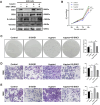ROS-mediated up-regulation of SAE1 by Helicobacter pylori promotes human gastric tumor genesis and progression
- PMID: 38351014
- PMCID: PMC10863176
- DOI: 10.1186/s12967-024-04913-5
ROS-mediated up-regulation of SAE1 by Helicobacter pylori promotes human gastric tumor genesis and progression
Abstract
Helicobacter pylori (H. pylori) is a major risk factor of gastric cancer (GC). The SUMO-activating enzyme SAE1(SUMO-activating enzyme subunit 1), which is indispensable for protein SUMOylation, involves in human tumorigenesis. In this study, we used the TIMER and TCGA database to explore the SAE1 expression in GC and normal tissues and Kaplan-Meier Plotter platform for survival analysis of GC patients. GC tissue microarray and gastric samples from patients who underwent endoscopic treatment were employed to detect the SAE1expression. Our results showed that SAE1 was overexpressed in GC tissues and higher SAE1 expression was associated with worse clinical characteristics of GC patients. Cell and animal models showed that H. pylori infection upregulated SAE1, SUMO1, and SUMO2/3 protein expression. Functional assays suggested that suppression of SAE1 attenuated epithelial-mesenchymal transition (EMT) biomarkers and cell proliferation abilities induced by H. pylori. Cell and animal models of ROS inhibition in H. pylori showed that ROS could mediate the H. pylori-induced upregulation of SAE1, SUMO1, and SUMO2/3 protein. RNA sequencing was performed and suggested that knockdown of SAE1 could exert an impact on IGF-1 expression. General, increased SUMOylation modification is involved in H. pylori-induced GC.
Keywords: EMT; Gastric cancer; Helicobacter pylori; ROS; SAE1; SUMOylation.
© 2024. The Author(s).
Conflict of interest statement
The authors declare that they have no competing interests.
Figures






Similar articles
-
SAE1 promotes human glioma progression through activating AKT SUMOylation-mediated signaling pathways.Cell Commun Signal. 2019 Jul 25;17(1):82. doi: 10.1186/s12964-019-0392-9. Cell Commun Signal. 2019. PMID: 31345225 Free PMC article.
-
Helicobacter pylori infection promotes Aquaporin 3 expression via the ROS-HIF-1α-AQP3-ROS loop in stomach mucosa: a potential novel mechanism for cancer pathogenesis.Oncogene. 2018 Jun;37(26):3549-3561. doi: 10.1038/s41388-018-0208-1. Epub 2018 Mar 22. Oncogene. 2018. PMID: 29563612
-
High expression of TRIP13 is associated with tumor progression in H. pylori infection induced gastric cancer.Mutat Res. 2024 Jan-Jun;828:111854. doi: 10.1016/j.mrfmmm.2024.111854. Epub 2024 Mar 8. Mutat Res. 2024. PMID: 38492425
-
Helicobacter pylori infection induces stem cell-like properties in Correa cascade of gastric cancer.Cancer Lett. 2022 Aug 28;542:215764. doi: 10.1016/j.canlet.2022.215764. Epub 2022 May 31. Cancer Lett. 2022. PMID: 35654291 Review.
-
Helicobacter Pylori and Gastric Cancer Progression.Curr Microbiol. 2022 Nov 3;79(12):383. doi: 10.1007/s00284-022-03089-9. Curr Microbiol. 2022. PMID: 36329283 Review.
Cited by
-
Cancer in connective tissue disease.Front Immunol. 2025 May 9;16:1571700. doi: 10.3389/fimmu.2025.1571700. eCollection 2025. Front Immunol. 2025. PMID: 40416966 Free PMC article. Review.
-
The impact of dysregulation SUMOylation on prostate cancer.J Transl Med. 2025 Mar 6;23(1):286. doi: 10.1186/s12967-025-06271-2. J Transl Med. 2025. PMID: 40050932 Free PMC article. Review.
-
Helicobacter pylori Infection in Patients with Gastric Cancer: A 2024 Update.Cancers (Basel). 2024 May 22;16(11):1958. doi: 10.3390/cancers16111958. Cancers (Basel). 2024. PMID: 38893079 Free PMC article. Review.
-
Impact of Helicobacter Pylori-Derived Outer Membrane Vesicles on Inflammation, Immune Responses, and Tumor Cell Migration in Breast Cancer Through the Snail/Β-Catenin Pathway.Rep Biochem Mol Biol. 2024 Jul;13(2):263-272. doi: 10.61186/rbmb.13.2.263. Rep Biochem Mol Biol. 2024. PMID: 39995644 Free PMC article.
-
Development of a prognostic oxidative stress-immune-inflammation score and online calculators for predicting survival and recurrence in gastric cancer: a multicenter study.Surg Endosc. 2025 Apr;39(4):2609-2624. doi: 10.1007/s00464-025-11596-6. Epub 2025 Mar 6. Surg Endosc. 2025. PMID: 40050495
References
Publication types
MeSH terms
Substances
Grants and funding
LinkOut - more resources
Full Text Sources
Medical
Molecular Biology Databases
Miscellaneous

